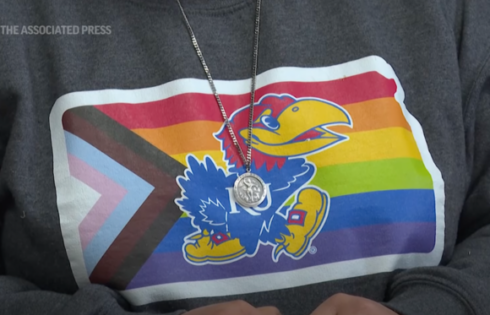 Monuments and historic artwork that offend a vocal minority are being torn down and covered up across the nation at a rapid clip. Ground zero for this Orwellian assault on our common history? Universities.
Monuments and historic artwork that offend a vocal minority are being torn down and covered up across the nation at a rapid clip. Ground zero for this Orwellian assault on our common history? Universities.
Roger Kimball, editor and publisher of The New Criterion, weighs in on this trend in the February 2019 edition of Hillsdale College’s Imprimis.
Below is an abbreviated version and the full piece can be read here.
The recent news that the University of Notre Dame, responding to complaints by some students, would “shroud” its twelve 134-year-old murals depicting Christopher Columbus was disappointing. It was not surprising, however, to anyone who has been paying attention to the widespread attack on America’s past wherever social justice warriors congregate.
Notre Dame, a Congregation of Holy Cross institution, may not be particularly friendly to its Catholic heritage. But its president, the Rev. John Jenkins, demonstrated how jesuitical (if not, quite, Jesuit) he could be. Queried about the censorship, he said, apparently without irony, that his decision to cover the murals was not intended to conceal anything, but rather to tell “the full story” of Columbus’s activities.
Welcome to the new Orwellian world where censorship is free speech and we respect the past by attempting to elide it.
Over the past several years, we have seen a rising tide of assaults on statues and other works of art representing our nation’s history by those who are eager to squeeze that complex story into a box defined by the evolving rules of political correctness. We might call this the “monument controversy,” and what happened at Notre Dame is a case in point: a vocal minority, claiming victim status, demands the destruction, removal, or concealment of some object of which they disapprove. Usually, the official response is instant capitulation. …
In the first place, the monument controversy involves not just art works or commemorative objects. Rather, it encompasses the resources of the past writ large. It is an attack on the past for failing to live up to our contemporary notions of virtue.
In the background is the conviction that we, blessed members of the most enlightened cohort ever to grace the earth with its presence, occupy a moral plane superior to all who came before us. Consequently, the defacement of murals of Christopher Columbus—and statues of later historical figures like Teddy Roosevelt—is perfectly virtuous and above criticism since human beings in the past were by definition so much less enlightened than we.
The English department at the University of Pennsylvania contributed to the monument controversy when it cheered on students who were upset that a portrait of a dead white male named William Shakespeare was hanging in the department’s hallway. The department removed the picture and replaced it with a photograph of Audre Lorde, a black feminist writer. “Students removed the Shakespeare portrait,” crowed department chairman Jed Esty, “and delivered it to my office as a way of affirming their commitment to a more inclusive mission for the English department.” Right.
High schools across the country contribute to the monument controversy when they remove masterpieces like Huckleberry Finn from their libraries because they contain ideas or even just words of which they disapprove.
The psychopathology behind these occurrences is a subject unto itself. What has happened in our culture and educational institutions that so many students jump from their feelings of being offended—and how delicate they are, how quick to take offense!—to self-righteous demands to repudiate the thing that offends them? The more expensive education becomes the more it seems to lead, not to broader understanding, but to narrower horizons. …
Consider some recent events at Yale University, an institution where preening self-infatuation is always on parade. Yale recently formed a Committee to Establish Principles on Renaming and a Committee on Art in Public Spaces. Members of the former prowl the campus looking for buildings, colleges, faculty chairs, lecture programs, and awards that have politically incorrect names. The latter police works of art and other images on campus, making sure that anything offensive to favored groups is covered or removed.
At the residential college formerly known as Calhoun College, for example—it’s now called Grace Hopper College—the Committee ordered the removal of stained glass windows depicting slaves and other historical scenes of Southern life. Statues and other representations of John C. Calhoun have likewise been slotted for removal. Calhoun, an 1804 Yale graduate, was a leading statesman and political thinker of his day. But he was also an apologist for slavery, so he has to be erased from the record.
Of course, impermissible attitudes and images are never in short supply once the itch to stamp out history gets going. Two years ago it was Calhoun and representations of the Antebellum South. More recently it was a carving at an entrance to Yale’s Sterling Memorial Library depicting an Indian and a Puritan. The Puritan, if you can believe it, was holding a musket—a gun! Who knows, perhaps he was a member of the NRA or at least could give inspiration to other members of that very un-Yale-like organization. According to Susan Gibbons, one of Yale’s librarian-censors, the presence of an armed Puritan “at a major entrance to Sterling was not appropriate.” Solution? Cover over the musket with a cowpat of stone—but leave the Indian’s bow and arrow alone!
Actually, it turns out that the removable cowpat of stone was only a stopgap. The outcry against the decision struck a chord with Peter Salovey, Yale’s president. “Such alteration,” he noted, “represents an erasure of history, which is entirely inappropriate at a university.” He’s right about that. But if anyone has mastered the art of saying one thing while doing the opposite it is President Salovey. He spoke against “the erasure of history.” But then, instead of merely altering the image, he announced that Yale would go full Taliban, removing the offending stonework altogether.
In the bad old days, librarians and college presidents were people who sought to protect the past, that vast storehouse of offensive attitudes and behavior that also just so happens to define our common inheritance. In our own more enlightened times, many librarians and college presidents collude in its effacement.
Someone might ask, “Who cares what violence a super-rich bastion of privilege and unaccountability like Yale perpetrates on its patrimony?” Well, we should all care. Institutions like Yale, Harvard, and Stanford are among the chief drivers of the “progressive” hostility to free expression and other politically correct attitudes that have insinuated themselves like a fever-causing virus into the bloodstream of public life. Instead of helping to preserve our common inheritance, they work to subvert it.
Spiriting away stonework in the Ivy League may seem mostly comical. But there is a straight line from those acts of morally righteous intolerance to far less comical examples of puritanical censure. …
So here we are. The old idea of tolerance was summed up in such chestnuts as, “I disapprove of what you say, but I will defend to the death your right to say it.” The new dispensation is: “I disapprove of what you say, therefore you may not say it.”
The Marxist-tinged ideology of the 1960s has had a few decades to marinate the beneficiaries of our free-market society, steeping them in the toxic nostrums that masquerade as moral imperatives in our colleges and universities. Today we find the graduates of those institutions manipulating the fundamental levers of political and corporate power.
The monument controversy shows the susceptibility of “liberating tolerance” to fanaticism. And it reminds us that in the great battle between the partisans of freedom and the inebriates of virtue, freedom is ultimately negotiable—until it rouses itself to fight back. At stake is nothing less than the survival of our common history.
MORE: Protesters forcibly topple Confederate war memorial statue at UNC
IMAGE: Mark Carrel / Shutterstock
Like The College Fix on Facebook / Follow us on Twitter




Add to the Discussion